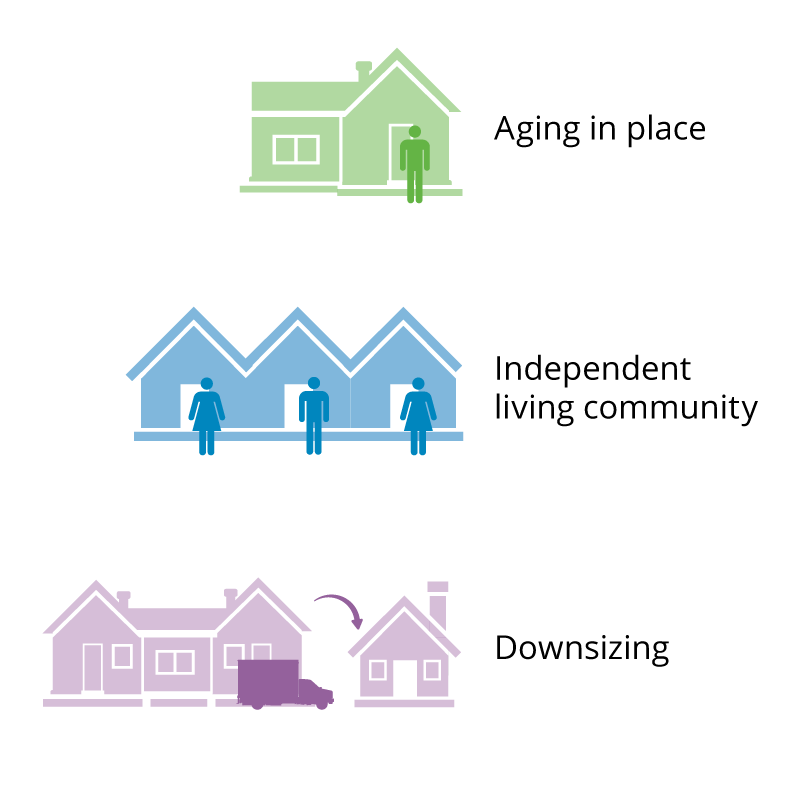Where Do You See Yourself?

As retirement draws nearer, the question of where to live as we age does too. Aging in place, moving to an independent living community, and downsizing all have their advantages, but there’s usually more than meets the eye in these situations.
Any of these options are great so long as the one you choose meets your individual needs, wants, and preferences. By being aware of the pros and cons of each, you can make a more informed choice and find the optimal place for you, ensuring a smooth transition into the next chapter of life.
Misconception #1: Aging in Place Is Ideal
Most older adults aged 50 to 80 (88%) feel it’s important to remain in their homes for as long as possible1—a popular sentiment among older Americans for more than a decade.
For many, aging in place is a means of maintaining their autonomy and independence. They likely have no mortgage payment and can manage their home financially. And, in a season of life that brings change and transitions, their longtime home also provides a daily sense of comfort and familiarity. Whether it’s morning greetings from neighbors, the companionship of a pet, or being surrounded by objects that represent cherished memories—being grounded in familiarity and routines can significantly benefit healthy aging.
With all these perks, aging in place seems like the best option, right?
Very Few Homes Are Aging-Ready
Naturally, safety risks and physical challenges increase with age. Yet, nearly half of older adults haven’t considered what kind of modifications may be necessary to safely remain in their home. This oversight leaves them unprepared for the serious risks that may come with aging in place.1
Falling is one of the major risks and is the leading cause of both fatal and nonfatal injuries in older adults.2 Even nonfatal injuries can lead to limited mobility or disability.
The Domino Effect of Falls
A fall that results in limited mobility or disability can lead to isolation, the second major risk to of aging in place, especially if you can no longer drive.
If caregiving is needed, help can be expensive and hard to find. Your home’s maintenance and upkeep could fall by the wayside, creating more safety risks.
But aging in place can still be a good option with careful planning. So where do you begin?
What You Can Do
When you’re in good health and getting along well, aging in place may seem like the best option. But the home that has suited you for years may not always be safe or manageable. If your goal is to age in place, AARP’s Your Home Checklist for Aging in Place offers a practical and thorough starting point for creating an age-ready home. Then contact an occupational therapist, who can educate you about aging safely and independently at home, and help you plan for current or anticipated challenges.
Misconception #2: Independent Living Communities Have It All
You’ve seen the advertisements: Commercials showing beautiful communities offering a wide array of amenities and activities on-site—no driving required—that look like they’d meet all your needs. These idealized advertisements highlight all the best parts of independent living communities, but is it the right fit for you?
For many older adults, this may be a great fit—especially for social butterflies. There are instant opportunities to make friends as well as a built-in network of support.
Adult kids find this option attractive, too
They won’t have to squeeze as many care-related responsibilities into their busy schedules, and they can rest assured their parents are safe, secure, and not alone.
On the surface, an independent living community can seem like a win-win.
But These Communities Aren’t for Everyone
If you’re not a social butterfly, living in a 55+ community can be challenging. Some find these communities too noisy or busy for their liking.
Those who enjoy having quiet and solitude tend to experience this issue most often. Some personalities don’t fit well in these bustling, close-knit neighborhoods. That’s not a criticism―just an acknowledgement that personal needs and preferences differ.
If pickleball games, book club, swimming, and movie nights, etc. aren’t of interest now, you probably won’t participate in them while residing in an independent living community. Yet you’d still be paying for these features.
Furthermore, if community members don’t share your values and interests, you could feel lonely even when surrounded by others. This doesn’t mean an independent living community is off the table altogether. It may just mean that you need to explore other options to find one that appeals to you.
What You Can Do
If this lifestyle is for you, visit and explore independent living communities. Contact the director and arrange to have lunch there. Sometimes guests can even stay overnight. While you’re there, ask yourself, “How do I feel being here? Do I see myself belonging?” Consider the size and location of the community. Read the reviews. Using these opportunities to gather data will help you make better-informed choices.






